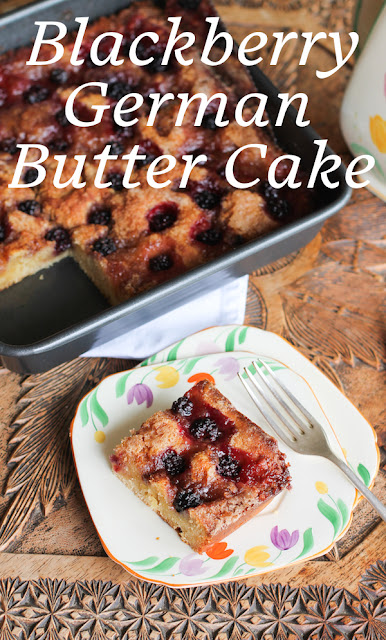
If you’ve never had butterkuchen or German butter cake, let me assure you that the name is well-deserved. This rich cake swims in the butter topping when it comes out of the oven. As the cake cools, the butter sinks in, making it super moist and delectable.
This month my Foodie Extravaganza friends are sharing German recipes to celebrate the Oktoberfest which, despite its name, starts on Saturday, 16 September in Munich, extending only slightly into October with an end date of October 3rd this year. Make sure to scroll down to see the dishes we’ve made in anticipation.
Meanwhile, you might want to check out my cheese-filled pretzels, homemade spicy German beer mustard and the obatza cheese spread I recreated for Sunday Supper, all three perfect for your Oktoberfest party.
This time around, I chose a sweet dish since every good and hearty meal should end with dessert, don’t you think? I'm pretty sure all German meals are good and hearty.
Blackberry German Butter Cake (Brombeere-Butterkuchen)
This recipe is adapted from several I found on the internet. Here are three: ChefKoch.de, Lecker.de and GermanFood.org. Don't let the yeast scare you! This cake is really quite simple to make.Ingredients
For the sponge:
1/4 cup or 31.25g flour
1 1/2 teaspoons dry yeast
1/2 cup or 120ml lukewarm milk (110°F or 43°C.)
1/2 teaspoon sugar
For the cake dough:
2 cups or 250g flour
1 large egg, at room temperature
7 tablespoons or 100g butter, softened, plus a little for buttering your baking pan
3/4 cup or 150g sugar
1/4 teaspoon salt
For the topping:
1/2 cup or 75g fresh berries, rinsed and drained
1/2 cup or 100g sugar
1 teaspoon cinnamon
9 tablespoons or 127g butter, softened
Method
To proof the yeast, we first make a sponge. Place flour in a large mixing bowl or stand mixer. Sprinkle in the dry yeast and add the teaspoon of sugar. Mix in the lukewarm milk.

Let the sponge sit in a warm place for 15 minutes. It should get foamy and increase in size. If it doesn’t, toss it out and start again with new yeast.
Assuming you have good, active yeast, add in the flour, egg, the softened butter, sugar and salt to the yeast mixture.
 |
| That's the foamy "sponge" on the bottom right. Good yeast! |
Mix until the dough is smooth and forms a ball.
One of the recipes I consulted online says to add up to 1/2 cup additional flour if necessary but I decided to leave my dough slack to make it more cake like, and less bready. So it didn’t really form a stiff ball. This probably makes it unauthentic, but, hey, I’m not even a little bit German plus I’ve added wild Jersey blackberries, so that makes it unauthentic already.

Cover the bowl with a damp cloth and leave to rise for 30 minutes in a warm place.
Press the dough out into a lightly buttered 8x8in or 20x20cm pan. Let it rest again for 15 minutes while heating oven to 375°F or 190°C.
Wet your hands slightly (so they don’t stick to the dough) and use your fingers to create dimples in the top of the dough.

Mix the sugar and cinnamon together with the berries and sprinkle evenly over dough.
Cut topping butter into small pieces and dot them evenly all around the cake. Mine was pretty soft so it was more a matter of spooning small bits on.

Bake in your preheated oven for about 25 minutes or until the cake is golden brown and the sugar on top has caramelized. There is still going to be quite a bit of butter bubbling on top but don’t worry, it will sink in as the cake cools.
Enjoy!
Many thanks to this month’s host, Sue of Palatable Pastime for choosing our theme and her behind the scenes work. It’s almost time for Oktoberfest! How will you celebrate?
- Autumn Crockpot Apple Sauerkraut by Faith, Hope, Love, & Luck Survive Despite a Whiskered Accomplice
- Bierocks by A Day in the Life on the Farm
- Braised Red Cabbage with Apples by Caroline’s Cooking
- Brombeere-Butterkuchen – Blackberry German Butter Cake by Food Lust People Love
- Chicken Schnitzel with Dunkelweizen Sauce by Palatable Pastime
- Chicken Schnitzel With Garlic Mayo by Sneha’s Recipe
- German meatballs with spaetzle by Cookaholic Wife
- Nusskämme (German Hazelnut Combs) by Tara’s Multicultural Table
Foodie Extravaganza celebrates obscure food holidays or shares recipes with the same ingredient or theme every month.
Posting day is always the first Wednesday of each month. If you are a blogger and would like to join our group and blog along with us, come join our Facebook group Foodie Extravaganza. We would love to have you!
If you're a reader looking for delicious recipes, check out our Foodie Extravaganza Pinterest Board!
Pin it!





.png)








































